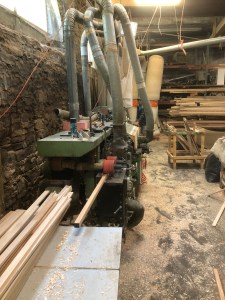44°55′7″ N 75°50′5″ W
When we bought Santosha in 2017 I noticed that there was some water damage to the port-side of the ceiling in the forward cabin (photo below).
The visible damaged spot was relatively small, only about a foot square but it was very noticeable and was going to be difficult to repair because the vinyl material had “shrunk” and could not be stretched back into place. In addition the plywood base it was adhered to was badly delaminated.
Upon closer inspection I determined that the damage had occurred because the gasket in the ceiling hatch had shifted out of place and water leaked in during heavy rains and/or when someone was over-enthusiastic when washing the forward deck with a hose.
To prevent any further damage Catherine made a waterproof vinyl cover for the hatch that securely fastens to the deck with dome snaps. It is several inches wider than the hatch on all sides so it provides lots of protection when it is in place. I also repaired the gasket on the underside of the hatch. No more leaks – even in the heaviest rains.
I spent a considerable amount of time thinking about ways to make a decent-looking repair to the ceiling but couldn’t come up with any worthwhile ideas. So I chose to ignore the “scar” on the ceiling because I had found the source of the leak and fixed it – but my guilt kept nagging at me – something had to be done. This past September I had a lot of time to work on the inside of the boat while Jay, my fiberglass guy was working on the hull so, no more excuses, the time had come for me to tackle the ceiling repair.
The ceiling in the forward cabin is basically made up of two large panels – one for the port side and the other for the starboard side. I tried to find the same vinyl material (photo below) as what was already installed so I would only have to repair the port side but was unable to find anything readily available with a pattern that was a perfect match. Not really a surprise for a boat that is almost 30 years old.
So, my next choice was to replace the entire ceiling using a fabric that would at least be complimentary to the ceilings in the rest of the boat. I settled for a white marine grade vinyl that has no pattern at all. I figured this would be a good choice because it should be relatively easy to find anywhere if additional repairs are needed at some time in the future – either in the forward cabin or somewhere else in the boat.
The ceiling panels are held in place by teak strips along all of the outer edges and at the seams where the panels meet. In addition, the wider sections were adhered to the underside of the foredeck with generous amounts of flexible caulking. This caulking resulted in me basically having to destroy each of the panels in order to get them off the ceiling.
Once the original panels were removed I did the best I could to put them back together so I could use them to make templates for the new panels. This worked – in a fashion.
I transferred the dimensions over to new 1/8″ thick door-skin plywood. This was the same thickness as the original plywood. Because of the layout of the cabin it was going to be very difficult to replace the ceiling with only two panels so I opted to divide the ceiling into four segments. This made each panel much easier to work with. Even so, I had a lot of “fun” fitting each panel in place because of all the unusual angles and curves that had to be matched. That was even evident in how the original panels were fitted. The teak trim strips hid a lot of small gaps!
Once I had the four plywood panels cut to fit I marked out the patterns on the underside of the vinyl and then cut it to fit each panel. I attached the vinyl to the panels using contact cement and let everything cure overnight. The next day I was able to install the panels and secure them to the ceiling with the teak trim strips.
I had never done anything like this before. It really was not all that difficult and I learned a lot through the process. The entire project cost less than $300 for the plywood and vinyl fabric and took about 12 hours over 3 days. If I ever have to tackle a job like this again I will not put it off for so long.
















 Lat/Long: 44.918701, -75.835843
Lat/Long: 44.918701, -75.835843













